A novel within a novel. A comic, painting, or song within a novel. Many writers enjoy the playfulness of creating fictitious works of art that no one will ever read, see, or hear.
I, too, love to play this game. Fictitious paintings and photographs lie at the heart of my genre-crossover novel, Sleeping Embers of An Ordinary Mind. It’s been immense fun to write, and during the long drafting and editing process, I’ve re-visited several novels, and read new releases, that share this compelling theme. Here are five of my personal favorites.
Station Eleven by Emily St. John Mandel
 Emily St. John Mandel depicts a post-apocalyptic world in which her characters desire more than mere survival. The central character, Kirsten, safeguards her own personal art treasures—two hand-drawn comic books, the hero of which is Dr. Eleven. Mandel’s interweaving and beautifully written narrative flits back and forth in time, connecting Kirsten with characters in the pre-apocalyptic world, including Miranda, the author of the unpublished comics.
Emily St. John Mandel depicts a post-apocalyptic world in which her characters desire more than mere survival. The central character, Kirsten, safeguards her own personal art treasures—two hand-drawn comic books, the hero of which is Dr. Eleven. Mandel’s interweaving and beautifully written narrative flits back and forth in time, connecting Kirsten with characters in the pre-apocalyptic world, including Miranda, the author of the unpublished comics.
“The Approach to Al-Mu’tasim” in Fictions by Jorge Luis Borges
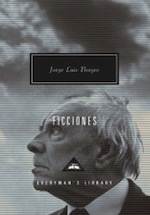 Borges is a brilliant, surreal, and fantastical writer who frequently blurs the boundary between reality and illusion. “The Approach to Al-Mu’tasim” is a short story that comprises a detailed review of a fictitious book, The Conversation with the Man Called Al-Mu’tasim: A Game of Shifting Mirrors, by a fictional author, Mir Bahadur Ali. The narrator even highlights the differences between two editions of the book. In a later autobiographical essay, Borges related that people took “The Approach to Al-Mu’tasim” at face value, and one of his friends tried to order a copy of the book from London.
Borges is a brilliant, surreal, and fantastical writer who frequently blurs the boundary between reality and illusion. “The Approach to Al-Mu’tasim” is a short story that comprises a detailed review of a fictitious book, The Conversation with the Man Called Al-Mu’tasim: A Game of Shifting Mirrors, by a fictional author, Mir Bahadur Ali. The narrator even highlights the differences between two editions of the book. In a later autobiographical essay, Borges related that people took “The Approach to Al-Mu’tasim” at face value, and one of his friends tried to order a copy of the book from London.
Breakfast of Champions by Kurt Vonnegut
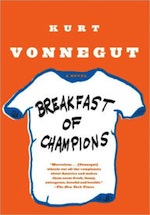 Kilgore Trout, a little-known pulp fiction author, is a character in several of Kurt Vonnegut’s stories and novels, including Slaughterhouse-Five (one of my favorite novels). In Breakfast of Champions, one of Trout’s stories has a devastating impact on wealthy Pontiac dealer Dwayne Hoover. He’s convinced by Trout’s story that he, the reader, is the only person alive with free will. He believes he’s surrounded by a race of robots and, terrified, embarks on a bloody rampage.
Kilgore Trout, a little-known pulp fiction author, is a character in several of Kurt Vonnegut’s stories and novels, including Slaughterhouse-Five (one of my favorite novels). In Breakfast of Champions, one of Trout’s stories has a devastating impact on wealthy Pontiac dealer Dwayne Hoover. He’s convinced by Trout’s story that he, the reader, is the only person alive with free will. He believes he’s surrounded by a race of robots and, terrified, embarks on a bloody rampage.
The Man in the Picture by Susan Hill
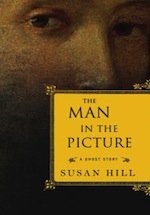 A Cambridge professor invites his former student to his university rooms where a small oil painting hangs on his wall—a disturbing scene at a masked carnival in Venice. A male figure in the foreground is restrained by two partygoers. He stares out of the painting as though trying to escape into the professor’s room. It’s a gothic ghost story in which the spooky painting entraps the professor and his unsuspecting student.
A Cambridge professor invites his former student to his university rooms where a small oil painting hangs on his wall—a disturbing scene at a masked carnival in Venice. A male figure in the foreground is restrained by two partygoers. He stares out of the painting as though trying to escape into the professor’s room. It’s a gothic ghost story in which the spooky painting entraps the professor and his unsuspecting student.
Never Let Me Go by Kazuo Ishiguro
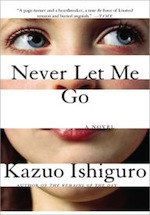 The children incarcerated at Hailsham boarding school spend endless hours in art classes, engaged in creative activities in the hope of winning praise from the school’s patron, Madame. They believe their best paintings and drawings will be exhibited in her London gallery. But it’s a ruse. Madame uses the paintings as evidence, hoping to convince society that the cloned children are truly human and should be treated better. In this heartbreaking coming-of-age novel, Tommy agonizes over his inability to paint, instilling pity in his friend Cathy, and contempt among other classmates. Ishiguro, a one-time songwriter himself, takes the title of this novel from the lyrics of a fictitious song.
The children incarcerated at Hailsham boarding school spend endless hours in art classes, engaged in creative activities in the hope of winning praise from the school’s patron, Madame. They believe their best paintings and drawings will be exhibited in her London gallery. But it’s a ruse. Madame uses the paintings as evidence, hoping to convince society that the cloned children are truly human and should be treated better. In this heartbreaking coming-of-age novel, Tommy agonizes over his inability to paint, instilling pity in his friend Cathy, and contempt among other classmates. Ishiguro, a one-time songwriter himself, takes the title of this novel from the lyrics of a fictitious song.
Anne Charnock‘s debut novel, A Calculated Life, was a finalist for the 2013 Philip K. Dick and Kitschies Golden Tentacle Awards. Her writing career began in journalism, and her articles appeared in the Guardian, New Scientist, International Herald Tribune, and Geographical. Her latest novel, Sleeping Embers Of An Ordinary Mind, spans from the 15th to the 22nd centuries in a multilayered narrative that asks questions about legacy, storytelling, and buried secrets. Find Anne on Twitter @annecharnock.










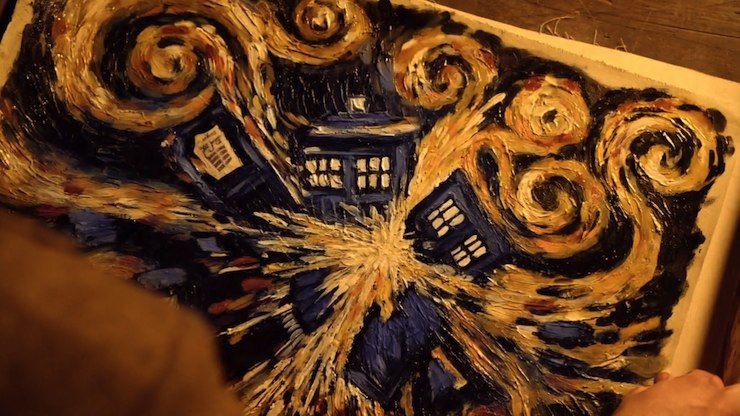
The Drowning Girl by Caitlin Kiernan. Immortal Love by Elizabeth Hand
I really like The Swan Thieves by Elizabeth Kostova. I can’t remember if the paintings are fictitious or real, but the story does very much revolve around the art.
The Hydrogen Sonata, the last Culture novel by Iain M. Banks, is named for (although not really about): “T. C. Vilabier’s 26th String-Specific Sonata For An Instrument Yet To Be Invented, catalogue number MW 1211, on one of the few surviving examples of the instrument developed specifically to play the piece, the notoriously difficult, temperamental and tonally challenged Antagonistic Undecagonstring – or elevenstring”
Don’t forget the very awesome, If on a winter’s night a traveler by Italo Calvino
“The Swordsman Whose Name Was Not Death”, both a novel and its theatrical adaptation, from Ellen Kushner’s The Privilege of the Sword.
Dare I mention the Bishop’s Bird Stump in To Say Nothing of the Dog, by Connie Willis?
Lots more of these.
Jo Walton’s The Philosopher Kings has a song about peace, written by Apollo, play an important role.
Greg Bear’s Songs of Earth and Power involves a concerto for orchestra. (Traditional fantasy has magic done via song; this one extends that to less-traditional arts such as architecture and winemaking.)
Michael Chabon’s The Amazing Adventures of Kavalier and Clay involves superhero comics about a hero named The Escapist.
H. P. Lovecraft’s story “Pickman’s Model” is about a painter whose dark fantasies may be less fantastical than they appear at first glance.
Of course there’s Oscar Wilde’s The Picture of Dorian Grey behind all these. Another more recent fantasy example I liked was The Golden Key by Kate Elliott, Jennifer Roberson and Melanie Rawn.
What of Shakespeare – The Taming of the Shrew, and also Hamlet?
My favorite is the Sarantine Mosaic (two books) by Guy Gavriel Kay. Loosely based on Byzantine history during the reign of Justinian (but in a fantasy-ish setting).
Your description of Fictions also reminds me a bit about the narrative conceit in the Princess Bride, along with people trying to find the ‘sequel’.
Lisamarie – good call on Sarantine. There also is the mysterious statue of the girl in the church in Kay’s Ysabel.
There is almost too much fictional art in SFF to count. The installation sculpture that ends up hurting Miles in Bujold’s Cetaganda. The blind sculptor who ends up married to one of the main characters in Zelazny’s Amber. The Martian translation and reinterpretation of Bible chapters in Zelanzy’s Rose for Ecclesiastes. A half-billion minstrel songs and poems in the works of Robin Hobbs (I’m only exaggerating a bit). Ditto re A Song of Ice and Fire (“A Bear! A Bear! And the Maiden Fair!”) Many, many more….
The Grasshopper Lies Heavy is a novel by Hawthorne Abendsen in Philip K Dick’s The Man In The High Castle, and will also I assume be in the TV series.
Card’s excellent short Unaccompanied Sonata.
A.S. Byatt’s Possession and The Children’s Book are my personal favorites for books containing fictitious works of art/literature.
The Golden Key by Melanie Rawn, Jennifer Roberson, Kate Elliott
Langford’s short story BLIT is one of those where the piece of art is actively harmful.
While it is true there are a lot of fantasy and books which involve major works of art as part of the plot, from Kvoth’s music in Kingkiller to the bardic songs in Anne McCaffrey’s pern series, (especially the Harper Hall trilogy), there are two for me not on the above list that really! Stand out as exceptional.
The first is the Novella The blue ladies by kate Wilhelm. This can be found in her collectionChildren of the wind.
It’s the story of an extremely grumpy, actually quite unpleasant old painter famous for his series of paintings “the blue ladies” and the girl he hires as his model, even though everyone is sure the painter is too old to paint straight or convincingly. I particularly liked this one Wilhelm does that rare thing, creates a protagonist who is really, unbelievably nice, yet who doesn’t feel as if the reader is meant! To like her (particularly since the painter is as nasty to her as he is to everyone else).
Maybe I liked this one since the protagonist reminded me so much of my lady and some of the things the story captures about her hit personal chords with me, nevertheless I’d highly recommend this one as a story where the art if not central to the story as a hole, but is used to say something really amazing and beautiful, —- quite surprising for an author who (in the same collection), does some down right creepy horror novellas too.
Second, one I must mention is Skallagrigg by William Horwood.
I could gush for hours about how much I love Horwood’s writing, and if you asked me which is my favourite novel, it’s probably a toss up between Skallagrigg and Duncton found.
Skallagrigg is not just a computer game, it is a game that explores limitations and disabilities but in a dark, artistic way which we get ever more hints of in the book. We learn through the course of the book not just the creation of the game, but how it ties together two stories, that of Arthur, a boy with cerebral palsy growing up in the 1920’s enduring horrible abuse at a hospital in the north of England, and that of Esther, a girl with the same condition 60 years later who writes the game Skallagrigg.
If any book treats a game as truly a work of art and one with as much of real human emotion, meaning and experience as a paintaing, especially a game of the 80’s with no huge 3d graphics or soulless corporate propheteering (excuse me, my bias is showing), that book is Skallagrigg.
And yet what is amazing is that the game is as much a springboard for the plot as the plot itself.
I won’t say anymore, but I would recommend Skallagrigg to everyone! Indeed a review of it by me can be found over on http://www.fantasybookreview.co.uk where I gush about it rather more.
A couple off the beaten path are the unfinished comic book in the excellent episode of Bones The Superhero in the Alley, and the series of paintings in the Three Investigator’s story The Mystery of the Shrinking House which are actually a clue.